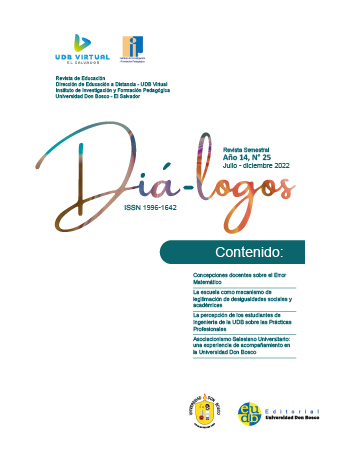The school as a legitimization mechanism of social and academic inequalities
Keywords:
education and culture, equal opportunities, Social inequality, social changeAbstract
DOI: https://doi.org/10.5377/dialogos.v1i25.15519
This article seeks to discuss the mechanisms that have transformed the school into an agency that legitimizes social and academic inequalities. To this end, three factors have been addressed that allow us to understand how the school tends to reproduce particularities of the dominant culture in society, which permeates the activities and training processes within educational institutions. The first factor is equality of opportunities which, in educational practice, generates unequal academic competition due to the diverse social strata of the students. The second factor is related to the social inequalities embedded in school practices that promote exclusion and academic failure. The last factor is merit as an educational practice that reveals the academic and social differences of students. It is concluded that equal opportunities contribute to legitimizing unequal competition among students to obtain diplomas and social positions. Furthermore, social inequalities promote exclusion and academic failure for the simple fact that these inequalities have been legitimized and have been expressed as the requirements for entry, permanence and graduation in educational institutions. Merit contributes to emphasizing the social and cultural differences of students because they have become the legitimized stimulus to justify academic performance, since it is believed that high grades are synonymous with intelligence and learning.
Downloads
References
Dubet, F. (2005). La Escuela de las Oportunidades: ¿Qué es una escuela justa? Gedisa Editorial.
FEDISAL. (2014). Un vistazo al contexto salvadoreño sobre los desafíos y expectativas en la búsqueda de la Educación Inclusiva. Formación & Empleo, 13 (1), 3-26
Feito, R. (2003). El sistema de enseñanza y estratificación social. En F. Fernández Palomares, Sociología de la educación (pp. 143–164). Pearson Prentice Hall.
Granados Martínez, A. (2003). Las funciones sociales de la escuela. En F. Fernández Palomares Palomares, Sociología de la educación. (pp. 117-140). Pearson Prentice Hall.
Juárez Ortega, F. A. (2006). Mi ojo derecho: Necesidades educativas especiales con o sin discapacidad. En P. Ganem Alarcón, Escuelas que matan 2: Las partes enfermas de las instituciones educativas. (pp. 133-147). Limusa Noriega Editores.
Matala Kabangu, T. (1997). Diversidad, desigualdad y desarrollo social. En J. Goikoetxea Piérola, y J. García Peña, Ensayos de pedagogía crítica. (pp. 161-167). Editorial Popular.
Ramos Mantecón, M. D. (2006). La foto del recuerdo: Los cuadros de honor no funcionan. En P. Ganem Alarcón, Escuelas que matan 2: Las partes enfermas de las instituciones educativas. (pp. 221-233). Limusa Noriega Editores.
Renes, V. (1997). Mesa redonda sobre diversidad, desigualdad y desarrollo social. En J. Goikoetxea, & J. Garcia Peña, Ensayos de pedagogía crítica. (pp. 153-160). Editorial Popular.
Published
How to Cite
Issue
Section
License

This work is licensed under a Creative Commons Attribution-NonCommercial-NoDerivatives 4.0 International License.









